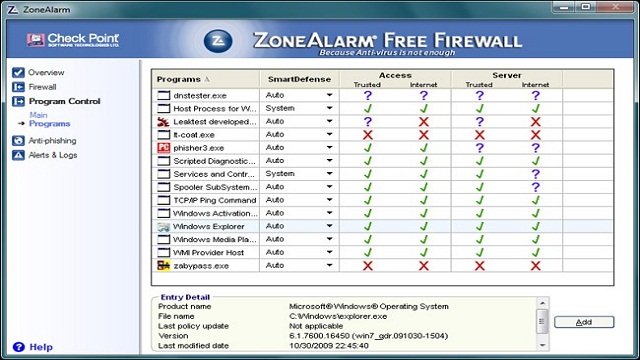Block Software Windows Xp Firewall Protection
Specifies that Windows Firewall blocks all unsolicited incoming messages. This policy setting overrides all other Windows Firewall policy settings that allow such messages.If you enable this policy setting in the Windows Firewall component of Control Panel the 'Block all incoming connections' check box is selected and administrators cannot clear it. 


Disable Firewall Windows Xp
You should also enable the 'Windows Firewall: Protect all network connections' policy setting; otherwise administrators who log on locally can work around the 'Windows Firewall: Do not allow exceptions' policy setting by turning off the firewall.If you disable this policy setting Windows Firewall applies other policy settings that allow unsolicited incoming messages. In the Windows Firewall component of Control Panel the 'Block all incoming connections' check box is cleared and administrators cannot select it.If you do not configure this policy setting Windows Firewall applies other policy settings that allow unsolicited incoming messages. In the Windows Firewall component of Control Panel the 'Block all incoming connections' check box is cleared by default but administrators can change it.
Especially Adobe Encore is missed by many. Recently after I had to create some DVDs for a client. Adobe encore cs4 library content torrent.
Block Software Windows Xp Firewall Protection
Probably the best way to do this is to use the 'lmhosts' file to define these names as going nowhere. • On the machine you called 'my machine', start up any text editor such as 'Notepad' • Navigate to and open the sample file: C: Windows System32 Drivers Etc lmhosts.sam • At the end of this file, add the following lines: 127.0.0.1 mac01 #PRE 127.0.0.2 mac02 #PRE • Save this file as the name 'lmhosts' (no extension) in the same directory as the lmhosts.sam file above. Note that Notepad will probably add '.txt' to the end of the file name.
If so, you need to rename this file with Explorer to eliminate the.txt extension. • Purge and Reload the name cache by bringing up a command prompt window (Start -> Run -> 'cmd') and enter the command: nbtstat -R (note it must be a capital 'R') • Now, your machine should not be able to access the machines 'mac01' and 'mac02' via UNC / NetBT. That depends a lot on the Firewall that you are using. Basically, you need to block UDP ports 136 and 137 and TCP ports 139 and 445 to/from the destination IP address (IP addresses of mac01 and mac02). Unfortunately if this is a network where the server devices get their IP address via DHCP, then they could have different IP addresses each time they are powered up making it nearly impossible to guarantee blocking them this way unless they are assigned fixed IP addresses. On the other hand, the method I outlined should block access via device name (no matter which IP address they obtain) but will not block them if access is requested via IP address. The more straightforward way (if you have XP Pro machines) is to disable Simple File Sharing on all your machines via policy and use regular access permissions to allow or deny access to these machines.